|
|
| Agents in a non-Microsoft clustered environment
on Windows can be installed from the active node in the cluster group using
the following procedure. The software can also be automatically installed
on all available passive nodes when the software is installed in the
cluster group, or you can choose to install any passive node(s) separately. This procedure covers agent installation for both VERITAS and HP Scalable
NAS/Polyserve Clustered environments. To verify which platform is supported
for the agent you are installing, see
Clustering Support
- Support.
Verify that all of the computers to which software will be installed
satisfy the minimum requirements specified in
System Requirements - Microsoft
Windows File System iDataAgent
for a cluster.
The following procedure describes the steps involved in installing the
application agent and the Windows File System
iDataAgent. If you choose to
install additional components simultaneously, refer to the appropriate procedures
for installation requirements and steps specific to the component. Note
that when you install multiple components, the sequence of the install steps
may vary.
Prepare for the virtual machine install as follows:
To trigger detection that the agent is being installed on a virtual node
in a non-Microsoft cluster, it is mandatory that you create the
bIgnoreClusterVMCheck registry key with a value of
1 on any node that is currently being installed.
For installs on a VERITAS cluster, locate the active node that is hosting
the cluster resources (i.e., that has access to the shared disk) and perform
the installation from this node in the cluster group.
For installs on a HP Scalable NAS/Polyserve Cluster,
- In the PolyServe Matrix Server, create a virtual host resource name
that has an assigned TCP/IP address in the network. Provide a virtual
host name (e.g., VirtualPolyServe.acme.com) and an Application name
(e.g., VirtualPolyServe). Select all network Interfaces that will be
available as hosts for the backup software services and click OK.
- From the Virtual Hosts tab in the PolyServe Matrix Server dialog
box, locate the primary node in the cluster group you are installing,
and perform the installation from the active (primary) host in the
cluster group. An installation will also be required for each inactive node
available to the vhost. You will be asked to provide the name of the
active host for each inactive host installation.
- During installation, the list of disk groups on the Virtual
Server
Selection dialog box will appear blank and will need to be manually
populated. For the disk group, provide the host name of the Virtual
Host created for backup; e.g., VirtualPolyServe. For the Communication
Interface Name, provide the fully qualified domain name of that host;
e.g., VirtualPolyServe.acme.com
- Preferred nodes are equivalent to eligible hosts and the current
owner node is always the active primary host.
- The client name should be equivalent to the vhost name and the interface
name equals the vhosts fully qualified domain name.
- Passive installs are required for all inactive hosts and require
you type in the name of the primary active host.
Review the following Install Requirements before installing the software:
General
- Review Install Considerations
before installing the software.
- Agents should be installed only after the CommServe and at least one MediaAgent
have been installed in the CommCell. Also, keep in mind that the CommServe®
software and MediaAgent must be installed and running (but not necessarily on
the same computer), before you can install the Agent.
- Close all applications and disable any programs that run automatically,
including anti-virus, screen savers and operating system utilities. Some of
the programs, including many anti-virus programs, may be running as a service.
Stop and disable such services before you begin. You can re-enable them after
the installation.
- Ensure there is an available license on the CommServe software for the Agent.
- Verify that you have the
Software Installation
Disc that is appropriate to the destination computer’s operating system.
Cluster
- If you are installing a File System
iDataAgent in the cluster group, a
Virtual File System license is required.
For more information about cluster license requirements, refer to
Clustering Support - License Requirements.
- Check the following on the cluster computer in which you wish to install the
software:
- Cluster software is installed and running.
- Active and passive nodes are available.
- Disk array devices configured with access to the shared array.
- Public Network Interface Card is bound first, before the private Network
Interface Card. (Does not apply to NetWare Cluster.)
- To trigger detection that the agent is being installed on a virtual
node in a non-Microsoft cluster, it is mandatory that you create the
bIgnoreClusterVMCheck registry key with a value of
1 on the node that is currently being
installed.
|
| 1. |
Place the Software
Installation Disc for the Windows platform into the disc drive. After a
few seconds, the installation program is launched.
If the installation program does not launch automatically:
- Click the Start button on the Windows task bar, and then click Run.
- Browse to the installation disc drive, select Setup.exe, click Open, then click OK.
NOTES
- If you are installing on Windows Server Core editions, mount to Software
Installation Disc through command line, go to the AMD64 folder and run
Setup.exe.
|
| 2. |
Choose the language you want to use during installation.
Click the down arrow and select the desired language from the drop-down list, and click Next to continue.
|
 |
| 3. |
Select the option to install software on this computer. NOTES
- The options that appear on this screen depend on the computer in which
the software is being installed.
|
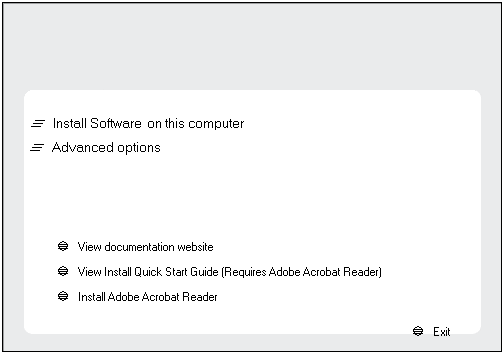 |
| 4. |
Read the license agreement, then select I accept the terms
in the license agreement. Click Next to continue.
|
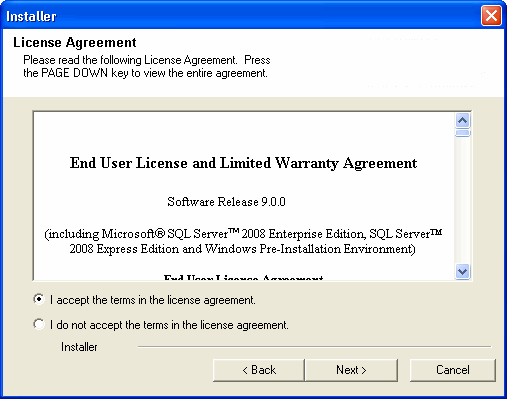 |
|
|
| 5. |
Select Configure a Virtual Server. Click Next to continue.
|
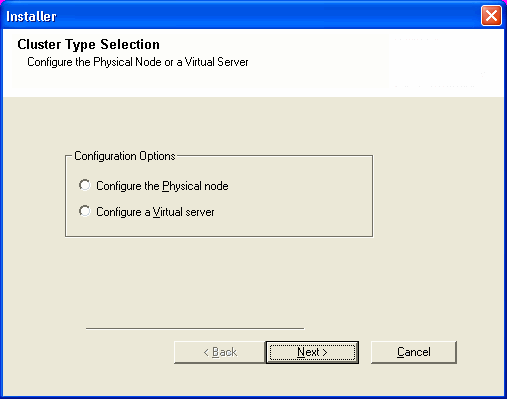 |
| 6. |
Select the disk group in which the cluster group resides. Click Next to
continue.
|
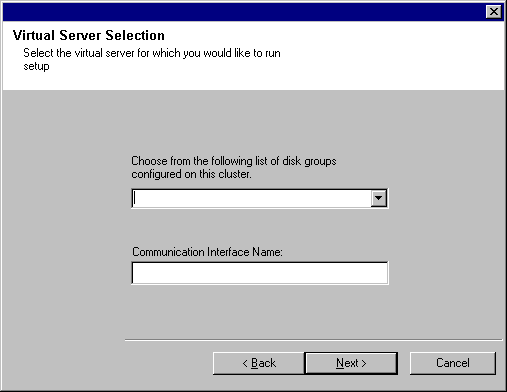 |
| 7. |
Add or remove the preferred nodes for running the selected Virtual Group. Also,
type the name of the current owner node (active physical node). Click Next to
continue.
|
 |
| 8. |
Click yes if it is the active node.
NOTES
|
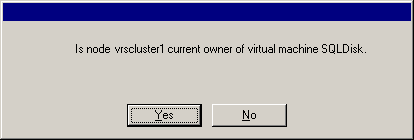 |
|
|
| 9. |
Select the component(s) to install. NOTES
- Your screen may look different from the example shown.
- Components that either have already been installed, or which cannot be installed, will be dimmed.
Hover over the component for additional details.
- If you wish to install the agent software for restore only, select
Install Agents for Restore Only checkbox. See
Installing Restore Only Agents for
more information.
- The Special Registry Keys In Use field will be highlighted when GalaxyInstallerFlags
registry key is enabled. Move the mouse pointer over this field to
see a list of registry keys that have been created in this computer.
Click Next to continue.
|
 |
| 10. |
Click Yes to set up the required privileges for the local administrators group.
NOTES
- This option will only appear if the Windows user account used to install
the software does not have the required administrator rights (e.g., if the
operating system was newly installed).
- If you choose to click Yes, the install program will automatically assign the
required rights to your account. You may be prompted to log off and log
back on to continue the installation.
- If you choose to click No, the installation will be aborted.
- You will be prompted at the end of the
installation to decide if you want these privileges to be revoked.
|
 |
 |
The install program checks
your Windows user account for the following necessary operating system
rights:
- Right to increase quotas (this is referred to as adjust memory
quotas for a process on Windows Server 2003).
- Right to act as a part of the operating system.
- Right to replace a process level token.
|
|
|
| 11. |
Enter the fully qualified domain name of the CommServe Host Name. This should be
TCP/IP network name. e.g., computer.company.com. NOTES
Click Next to continue.
|
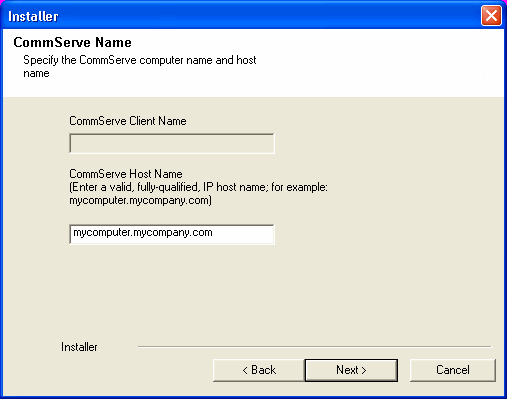 |
| 12. |
Enter the username and password associated with an external
domain user account or a CommCell user account to authorize the installation
of this agent. NOTES
- This window will be displayed when the Require Authentication for Agent
Installation option is selected in the CommCell Properties. For more
information, see
Authentication for Agent Installs.
Click Next to continue.
|
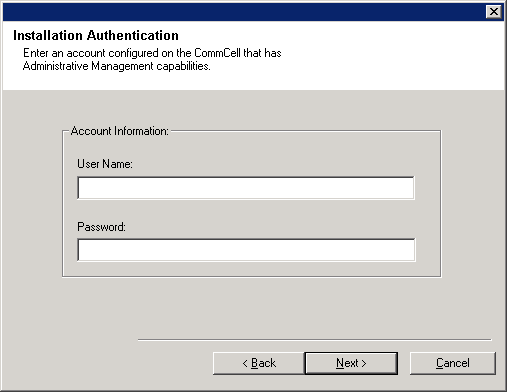 |
| 13. |
Enter the following:
- The local (NetBIOS) name of the client computer.
- The TCP/IP IP host name of the NIC that the client computer must use to communicate with the CommServe
Server.
NOTES
-
Do not use spaces when specifying a new name for the Client.
- The default network interface name of the client computer
is displayed if the computer has only one network interface. If the
computer has multiple network interfaces, enter the interface name that
is preferred for communication with the CommServe Server.
- If a component
has already been installed, this screen will not be displayed; instead, the
install program will use the same name as previously specified.
Click Next to continue.
|
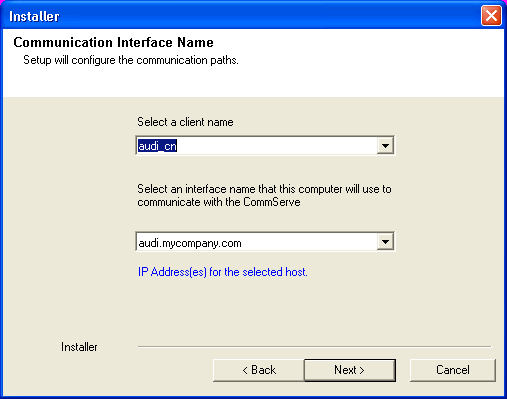 |
| 14. |
Select Add programs to the Windows Firewall Exclusion List, if
you wish to add CommCell programs and services to the Windows Firewall
Exclusion List.
NOTES:
Click Next to continue.
|
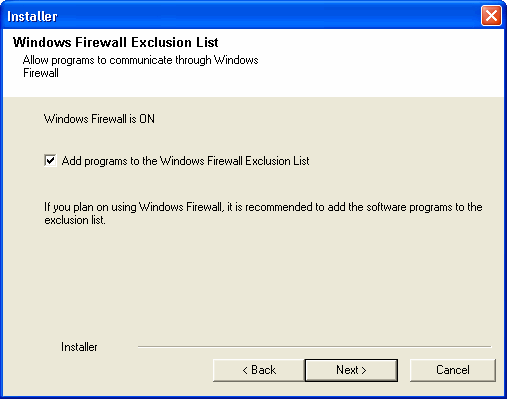 |
|
|
| 15. |
Click the name of the Virtual SQL instance and then click Next to continue.
NOTES
- If you do not see the name of the Virtual SQL instance, type the name in the drop down.
|
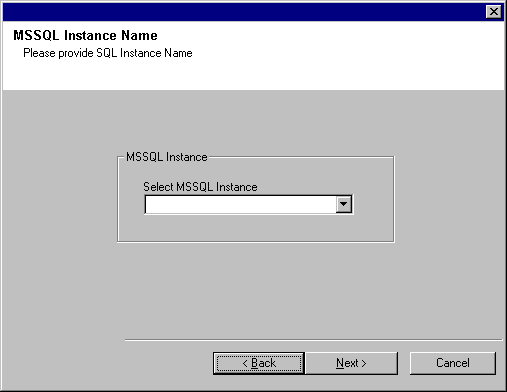 |
| 16. |
Specify the location where you want to install the software. NOTES
- Do not install the software to a mapped network drive.
- Do not use the following characters when specifying the destination path:
/ : * ? " < > | #
It is recommended that you use alphanumeric characters only.
- If you intend to install other components on this computer, the selected installation directory will be automatically used for that software as well.
- If a component is already installed in this computer, this screen may not be displayed.
The software will be automatically installed in the same location that was
previously specified.
Click Browse to change directories.
Click Next to continue.
|
 |
|
|
| 17. |
Select a Client Group from the list. Click Next to continue.
NOTES
- This screen will be displayed if Client Groups are configured in
the CommCell Console. For more information, see
Client
Computer Groups.
|
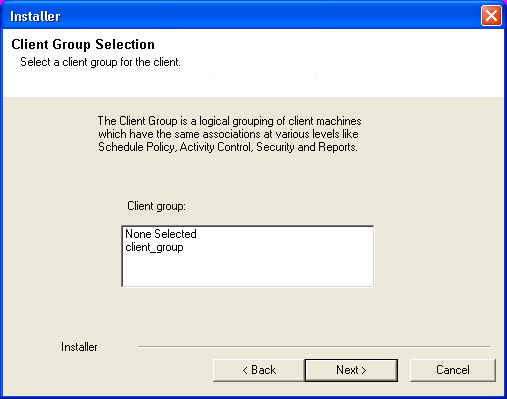 |
|
|
| 18. |
Select the name of the Content Indexing Engine (referred to as the
Content Indexing Cluster) that must be used to content index the client. NOTES
- This option will be displayed only if you have already installed the
Content Indexing Engine.
- If you have not already installed the Content Indexing Engine, you will
be prompted to configure the Content Indexing Engine from the subclient
after the install, using the CommCell Console.
Click Next to continue.
|
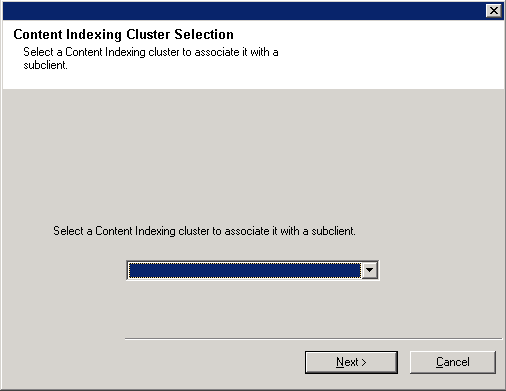 |
|
This section is applicable if you are installing Exchange Database and/or
Exchange Mailbox iDataAgents.
|
| 19. |
Select the backup type for Exchange Database backups. Choose either of the
following options, then click Next to continue:
- Differential - Backs up all new and changed data since the last full backup.
- Incremental - Backs up all new and changed data since the last full backup or incremental backup. The Incremental backup type is selected by default.
A backup type is the selected partial backup that you run between full
backups. In this window, you select the backup type that you want for this
client.
|
 |
| 20. |
The install program displays a reminder to verify that Circular Logging is disabled before performing any database backup operations. To verify that Circular Logging is disabled:
- From Exchange System Manager, navigate to and expand the server that the Database
iDataAgent is being installed on.
- Verify that the Circular Logging check box has not been selected for each Storage Group. If Circular Logging has been enabled for a Storage Group, disable it at this time.
Click OK to continue.
|
 |
| 21. |
If you are installing the Exchange 2007 Database
iDataAgent, then
specify the Exchange Administrator information and click Next to
continue. Otherwise, skip to the next step.
Account Name - Domain user account created with the proper permissions. Do not include the domain name here.
Account Password - The password assigned to the domain user.
Domain - The Windows domain that the Exchange Server resides in. The installation detects and enters a domain name. If necessary, this field can be modified.
|
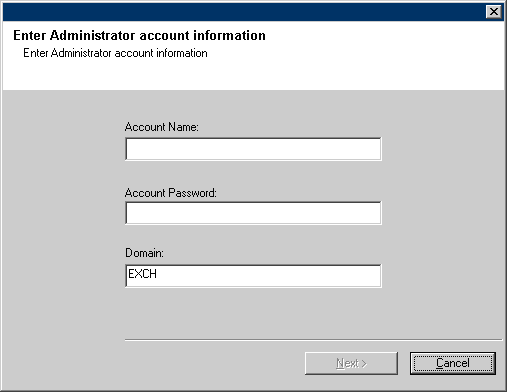 |
| 22. |
Enter the following Exchange Administrator information then click Next to continue:
Account Name - Domain user account created with the proper permissions. Do not include the domain name here.
Account Password - The password assigned to the domain user.
Mailbox Name for this Account -
Mailbox associated with the user above.
Profile Name - Created during agent
install. This profile is associated with the domain user's mailbox.
Exchange Server Name - Name of the Exchange
Server that the agent will communicate with for data protection and recovery
operations.
Domain - The Windows domain that the Exchange Server resides in. The installation detects and enters a domain name. If necessary, this field can be modified.
NOTES
- If you are installing the agent on a 32-bit off-host proxy computer,
or are performing a multi-instance proxy fanning install, ensure that
you enter the name of the appropriate Exchange Server in the
Exchange Server Name field. In some
cases, a pre-populated default value for this field will appear and
may need to be changed depending on your configuration.
See the
Exchange Agents section in User Accounts and Passwords for more
information.
|
 |
|
This section is applicable if you are installing Exchange Database Mining
Tools.
|
| 23. |
Specify the folder in a secure location for authorized users to access the
Exchange Offline Mining Tool for Administrators. Click Browse to change directories.
Click Next to continue.
NOTES
- This step is only applicable when installing the Exchange Offline Mining
Tool for Administrators.
|
 |
| 24. |
Specify the folder in a shared location for end users to access the Exchange
Offline Mining Tool. Click Browse to change directories.
Click Next to continue.
NOTES
- This step is only applicable when installing the Exchange Offline Mining
Tool (for end users).
|
 |
|
|
| 25. |
If necessary, select this option to schedule an automatic installation of software
updates.
NOTES
Click Next to continue.
|
 |
|
|
| 26. |
Select the storage policy through which you want to back up/archive the agent. NOTES
- A storage policy directs backup data to a media library.
- If desired, you can change your storage policy selection at any time
after you have installed the client software.
- This screen may appear more than once, if you have selected multiple
agents for installation. You will be prompted to configure the storage
policy association for each of the selected agents.
Click Next to continue.
|
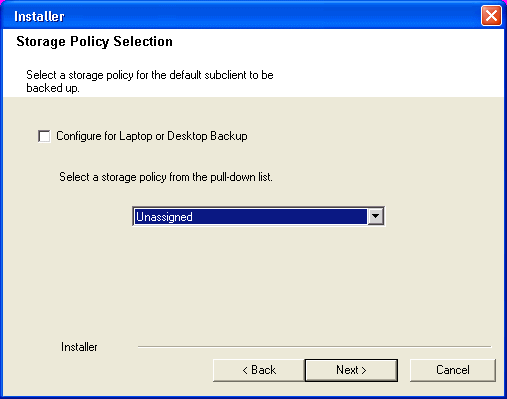 |
|
|
| 27. |
Verify the summary of selected options.
NOTES
- The Summary on your screen should
reflect the components you selected for install, and may look different from
the example shown.
Click Next to continue or
Back to change any of the options.
The install program now starts copying the software to the computer.
This step may take several minutes to complete.
|
 |
| 28. |
The System Reboot message may be displayed. If so, select one of the following:
- Reboot Now
If this option is displayed without the
Skip Reboot
option, the install program has found files required by the software
that are in use and need to be replaced. If Reboot Now is displayed
without the Skip Reboot option, reboot the computer at this point. The
install program will automatically continue after the reboot.
- Exit Setup
If you want to exit the install program, click
Exit
Setup.
|
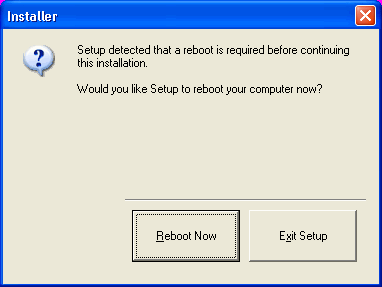 |
|
|
| 29. |
Click OK and manually configure the cluster resources.
NOTES
- For more information on configuring the cluster resources, see the
following:
|
 |
| 30. |
Click Next to continue.
NOTES
- Schedules help ensure that the data protection operations for the
Agent are automatically performed on a regular basis without user intervention.
For more information, see Scheduling.
|
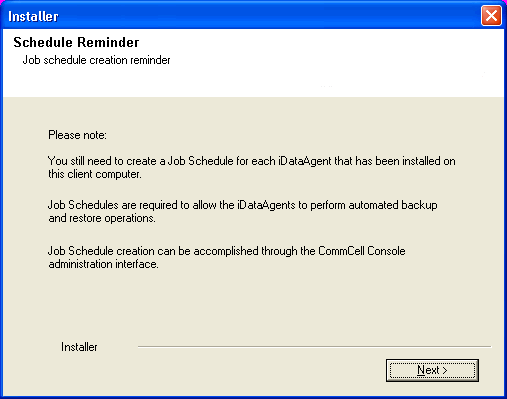 |
| 31. |
Click Yes to remove the privileges that were assigned earlier by the
install program. If you do not wish to remove them, click No.
NOTES
- This option will only be displayed if you were prompted to assign the
privileges earlier in the installation.
|
 |
| 32. |
Setup displays the successfully installed components.
NOTES
- The Setup Complete message displayed on
your screen will reflect the components you installed, and may look different
from the example shown.
- If you install an Agent with the CommCell Console open, you need to
refresh the CommCell Console (F5) to see the new Agents.
- If Reboot Now button is displayed make sure to reboot the
computer before performing any other operations from the computer.
Click Finish to close the install program.
The installation is now complete.
|
 |
| 33. |
Note that the following will automatically be filtered:
- The physical cluster nodes will automatically filter all shared disk
resources.
- Cluster group will automatically filter all physical disk resources.
NOTES
- Automatic filtering is not supported for non-Microsoft clusters.
For non-Microsoft clusters, volume filtering should be controlled by
defining subclient filtering and/or contents.
|
General
-
Install post-release updates or Service Packs that may have been released
after the release of the software. When you are installing a Service Pack,
ensure that it is the same version as the one installed in the CommServe Server.
Alternatively, you can enable
Automatic Updates for quick and easy installation
of updates in the CommCell component.
- After installing the Agent, you may want to configure the Agent before running
a data protection operation. The following list includes some of the most common
features that can be configured:
- Configure your subclients - see
Subclients
for more information.
- Schedule your data protection operations - see
Scheduling
for more information.
- Configure Alerts - See
Alerts and Monitoring
for more information.
- Schedule Reports - See
Reports for more
information.
The software provides many more features that you will find useful. See the
Index for a complete list of supported
features.
Agent Specific
-
The following configuration tasks are required before performing an Archive
Operation using this Archiver Agent:
- Create a Subclient - see
Subclients - File Archiver
for Windows for more information.
-
Archiving Rules are initially disabled by default. You must clear the Disable All Rules option in the Subclient Properties (Archiving Rules) or (Rules) tab and configure the archiving rules before conducting rules-based Archive Operations.
-
After the installation, you must use the system to add an instance for the iDataAgent
so that you can back up the SQL databases. To add an instance, see
Add a SQL Server
Instance for step-by-step instructions. Instances are automatically
discovered if enabled during installation or in the agent Properties dialog box.
-
Several configuration tasks are required before you schedule or run
content indexing operations on the data. See
Configuration - Content Indexing
and Search page for more information.
-
Certain configuration tasks must be performed prior to using the Exchange Offline Mining Tools. For more information, see
Configuration.
Disaster Recovery Considerations
- Before you use your agent, be sure to review and understand the associated
full system restore (or disaster recovery) procedure. The procedure for some
agents may require that you plan specific actions or consider certain items
before an emergency occurs. See
Disaster Recovery for more information
regarding your agent.
Cluster
- If the passive node was not available while installing/upgrading
the software, you must manually install/upgrade the software on the
passive node now. (See Manually
Installing the Software on a Passive Node for step-by-step instructions.)
- By default, a failure of MediaAgent or Agent software on the active
node in a Windows, Veritas, or HP Scalable NAS/Polyserve Cluster will
not cause a failover to be initiated. For information on how
to change this default behavior, see
Clustering Support - Failovers.
- To uninstall, start, and stop windows services on a local computer,
use the instsvc utility. For more information,
see
List of Tools and Utilities.
In case of VERITAS Cluster you must manually install/upgrade the
software on all the available Nodes.
For installs/upgrades on the VERITAS Cluster, complete the following
procedures for the agent. These procedures can be completed using the
VERITAS Cluster Administrator.
Create the Cluster Resources for Services
Once the physical nodes and the virtual machine are installed/upgraded,
services should be added as generic services. Also, you may want to
designate the services as "critical" if you want to cause the virtual
machine to fail over if the associated service stops.
- In Windows Services, locate the services for each installed/upgraded
cluster (e.g., Bull Calypso Cluster Plugin (penodevn1_netwo) (instance001))
right-click and select Properties, and locate the service name in
the General tab (e.g., GxClusPlugin
(penodevn1_netwo) (Instance001))
|
The service name is case- and space-sensitive, so record it exactly as it appears. |
- In Cluster Administrator, navigate to the appropriate Cluster
group. Create a generic service resource for the cluster plugin
service.
- If you want an automatic failover to occur, mark the resource as
Critical and Enabled.
- Repeat this procedure for each client installed on the cluster.
Create Service Dependencies
- In Cluster Administrator, click Resources.
- Click Link and make
the Cluster plugin
resource dependent upon the Mount resource and the Lanman service.
Associate Services with the Current Active Node
- In Cluster Administrator, navigate to the appropriate
GenericService group.
- Right-click the cluster plugin resource. From the short-cut
menu, click Online and the name of the current active node.
Important Considerations
-
Windows File System:
Backups of local physical node volumes from virtual nodes are not
recommended. Set the virtual node default subclient content to the shared disk
resource(s) instead of using auto detection (/), or create a subclient to use
for backups with the shared disk resource(s).
-
Image Level
For Non-Microsoft cluster, create the file
<JobResults Directory>\CVClusterVolumes.txt with a list of drives
in it. For example, the file can contain "D: E: F:".
For installs/upgrades on the HP Scalable NAS/PolyServe Cluster, complete the
following procedures for the agent.
Create and Use Scripts to Administer Virtual Machine Services
You should create and use three scripts to administer virtual machine
services:
- Probe script is used to reveal the state of the specified
services. This is done using the GxSCMCmd.exe utility.
- Start script is used to start services.
- Stop script is used to stop services.
Create a probe script to have the status of both the
Bull Calypso Communications
Service (GxCVD) and the
Bull Calypso Event Manager
Service (GxEvMgrC) checked. In the probe script, include the
GxSCMCmd.exe utility by name in the appropriate command. (This
utility is available from the Resource Pack. See
Tools and Utilities for more information.) Create a folder (e.g.,
m:\GxSCMCmd) on a shared disk that the virtual host you created
has access to. Copy the
GxSCMCmd.exe utility and the
script files you created (probe.bat, start.bat,
stop.bat) to this folder. The utility will return the state of
the specified services: '0' if the services are running or '1' if
services are stopped. For an error condition, '-1' is returned. Note
that the service name includes the name of the client and the name of
the instance. To avoid error in providing the vhost name and instance
name in the path of scripts, copy the key name from here:
HKEY_LOCAL_MACHINE\SYSTEM\CurrentControlSet\Services\GXClusPlugIn
(vhostname) (Instance00x)
|
These examples provide sample script names, locations and virtual host name as
suggested names not requirements. |
The command syntax is:
GxSCMCmd.exe -IsRunning <list of service name>
For example, your probe script (e.g., m:\GxSCMCmd\gxprobe.bat) may appear as follows:
@echo off
if'%MX_ACTIVE_STATE%'='INACTIVE' exit 0
m:\GxSCMCmd\GxSCMCmd.exe -IsRunning "GxClusPlugIn
(virtualpolyserve) (Instance001)"
if ERRORLEVEL 0 exit 0
exit 1
Be sure to copy the GxSCMCmd.exe utility to the shared disk resource. Also, be sure
to include the probe script on the shared disk.
The stop and start scripts must also contain the registry entry for
the virtual machine service names. Your start script (e.g.,
m:\GxSCMCmd\gxstart.bat) may appear as
follows:
@echo off
C:\WINDOWS\system32\net.exe start "GxClusPlugIn
(virtualpolyserve) (Instance001)"
exit 0
Your stop script (e.g.,
m:\GxSCMCmd\gxstart.bat) may appear as
follows:
@echo off
C:\WINDOWS\system32\net.exe stop
GxClusPlugIn (virtualpolyserve) (Instance001)
exit 0
Add the Customer Service Monitor
Add the custom service monitor to the virtual host configuration in
the PolyServe Matrix Server console.
- Ensure that the virtual host name
<virtualpolyserve> is online.
- From the Services MMC snap-in, verify or manually start the
cluster plugin service, "Bull Calypso
Cluster Plugin
(virtualpolyserve)
(Instance00x)",
on the active primary node for the Vhost
virtualpolyserve
- From the PolyServe Matrix Server, click the
Virtual Hosts tab.
- Right click Virtual Host <virtualpolyserve>
and then Add Service Monitor.
- For the Monitor Type field in the Add Service Monitor dialog box, click
CUSTOM.
- Assign a name to the service monitor by typing the name in the
Name field.
- In the User probe script field, type the path to the probe script that
calls the GxSCMCmd.exe command (on the share disk)
- Click Advanced.
- From the Advanced Service Configuration dialog box, click the Scripts tab.
- In the Script pathname: Start field, type the path to the start script
(shared disk). In the corresponding Timeout (seconds) field, type a timeout value greater than 60
seconds.
- In the Script pathname: Stop field, type the path to the stop script
(shared disk). In the corresponding Timeout (seconds) field, type a timeout value greater than 60
seconds.
- Click OK once, then again.
The monitor should now start, and the primary node should now be
active. Failover will occur if services are disabled on the primary
node, and services in such a case will move to a secondary node.
|






























